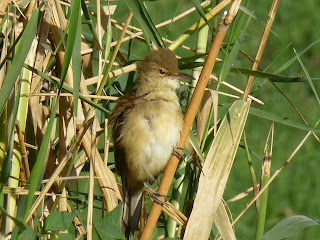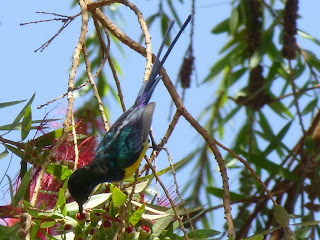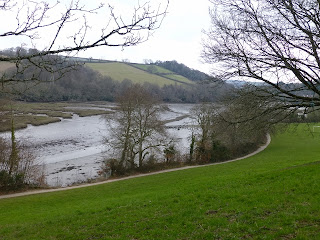Wednesday 27th February and I headed off to Slapton Ley on the bus. It was cold and grey with a biting Easterly wind, not a good day to have left my hat at home but luckily my coat has a hood which I was very glad of as it was freezing! The light was pretty poor but I managed a few good sightings in the murk.
Arriving at Torcross I soon found the 3 black necked grebes resting and preening together close to the hide before they split off in to a pair and a single. One of the pair was developing summer plumage with a black neck and yellow face plumes contrasting nicely with the red eyes.
Winter Plumaged Black Necked Grebe
Black Necked Grebe developing Summer Plumage
Mid Ley I found a very smart male scaup amongst the tufted ducks, presumably the immature male developing adult plumage I saw back in January.
Male Greater Scaup with male Tufted Duck
Scaup and Tufted Duck
At the bridge end of the Ley I found a female scaup amongst the tufted duck and eventually the male and then the female ring necked ducks. The ring necks spent most of their time separate from each other but would occasionally associate together. A nearby birder called 2 bittern at the back of Ireland Bay but by the time I had moved to a place where I could see in to the Bay they had disappeared in to the reeds - never mind.
Male Ring Necked Duck
Male Ring Necked Duck with male Tufted Ducks
Offshore from the car park around 100 common scoters were close in to the shore in a long strung out raft with small groups flying off East before landing again, the raft gradually moving East but giving some nice views of both males and females. Later at the Torcross end I saw a distant red throated diver preening on the sea as it appeared and disappeared amongst the wave troughs.
A Cettis warbler was briefly heard before deciding it was far too cold to waste energy on singing and on the Ley 5 male and 7 female goldeneyes were busily displaying for brief periods. Good numbers of pochard and coot were seen with a few wigeon in Ireland Bay. The bathing gulls on the Ley included a few lesser black backs and commons.
A surprise was a dead adder I nearly stepped on in a cleared area by the Leyside footpath, presumably disturbed from hibernation where the vegetation had recently been cleared. My instinct kicked in before I had time to think as I leapt backwards on spotting it before realising that no live adder would be out and about in the freezing temperature.
Very dead Adder!
Thursday 28th February and we headed off to the National Trust house and gardens at Knightshayes near Tiverton. On the drive up along the A38 we saw a dead otter by the roadside near Buckfastleigh. Maybe it was an escape from the nearby Otter Park or maybe a wild animal from the nearby River Dart but either way sad to see.
Knightshayes was very interesting with 2 ravens, 2 buzzards and siskins flying overhead calling, singing and displaying. A pair of sparrowhawks were also displaying with the smaller male doing an undulating display flight over the tree tops while the female soared in direct flight.
Male Blackbird at Knightshayes
On the drive home just as we reached Marsh Mills at Plymouth a red kite was seen soaring high overhead heading in a North Easterly direction - well, it may have been a black kite as it was so high overhead but more likely a red considering the time of year and recent reports of red kites in Devon and Cornwall.
Friday 1st March and I headed off for a short walk at Ernesettle Creek to clear my head after a few too many drinks the night before. The lesser yellowlegs was nowhere to be seen from the slipway where I usually see it so I headed off to the Creek mouth where a pair of red breasted mergansers and 6 great crested grebes ( 3 in summer plumage) were seen on the River Tamar. 8 black tailed godwits were feeding on the mudflats before flying off to join 26 birds feeding in Kingsmill Lake on the Cornish side of the river.
Ernesettle Creek from the bus stop
Heading back to the slipway and movement in the bushes by the footpath turned out to be a very smart firecrest doing its usual trick of showing very well for a few seconds before disappearing in amongst the branches before reappearing again, they do not stay still for a second!
The lesser yellowlegs eventually showed very well upriver form the slipway, preening at the waters edge and feeding on the mudflats. When it found a worm it would run down to the waters edge to wash it before eating it, running the gauntlet of the nearby gulls - I guess muddy worms do not taste good! Redshank numbers along the Creek have dropped and there were fewer gulls around too but teal numbers seen much the same. Only 2 greenshanks were seen and a lone little egret while a green woodpecker was heard yaffling in the nearby woods.
Little Egret with a Greenshank at Ernesettle Creek
It has been very nice having the lesser yellowlegs overwintering here in Plymouth, last winter we had the spotted sandpiper wintering on the River Plym and it has been nice to be able to regularly visit somewhere close to home to see a rare bird and some good supporting birds too for 2 winters running.
















































